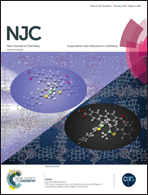Synthesis of novel TEMPO stable free (poly)radical derivatives and their host–guest interaction with cucurbit[6]uril†
Abstract
A number of ten stable free mono-, di- and tri-radicals of the TEMPO nitroxide type were synthesized and characterized via physico-chemical methods (elemental analysis, MS, UV-Vis, IR, ESR, and X-ray, where appropriate). The design of the compounds was chosen such that supramolecular interaction could be gained via hydrogen-bonding or π–π interactions; therefore the compounds should contain amino- or urea-moieties, (nitro)aromatic rings, or a crown ether residue. The formation of inclusion complexes between these (poly)radicals and cucurbit[6]uril was studied via Electron Spin Resonance (ESR) spectroscopy. The binding constants were evaluated from the analysis of the rotational correlation time dependence on the concentration of cucurbit[6]uril. These constants are an order of magnitude lower than the values reported before for complexes of TEMPO derivatives with β-cyclodextrin. The complexation behaviour of cucurbit[6]uril was revealed in the ESR spectra of the nitroxides in the presence and in the absence of the host molecules, recorded at low temperatures. The experiments revealed that the mobilities of the nitroxides investigated are higher in the absence of the host molecule, a different behaviour compared with complexes with cyclodextrins. This behavior can be understood by taking into account the role played by the presence of salts necessary to ensure the solubility of cucurbit[6]uril in water.
![Graphical abstract: Synthesis of novel TEMPO stable free (poly)radical derivatives and their host–guest interaction with cucurbit[6]uril](/en/Image/Get?imageInfo.ImageType=GA&imageInfo.ImageIdentifier.ManuscriptID=C5NJ01518A&imageInfo.ImageIdentifier.Year=2016)

 Please wait while we load your content...
Please wait while we load your content...